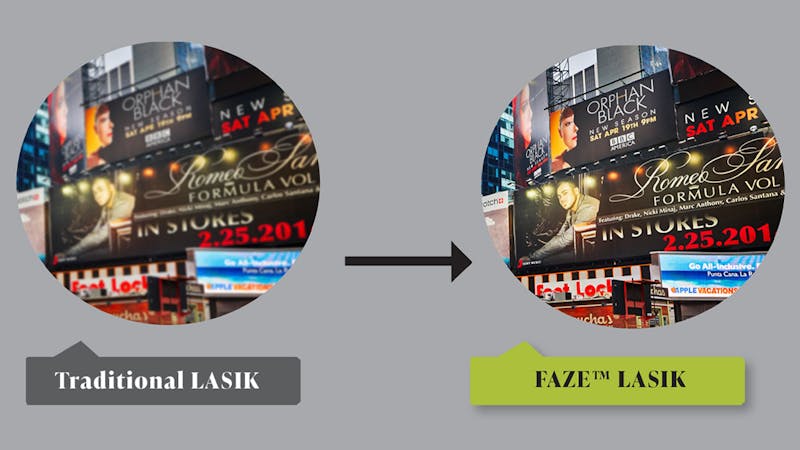Enhancing Your Vision
Guiding you toward the procedure that fits your unique needs, so you can see the world clearly and confidently.

Beyond Traditional LASIK: Discovering the Hidden Key to Perfect Vision.
Are you thinking about getting LASIK? Or maybe you've already had the procedure but still struggle with less-than-perfect vision? What if I told you there’s an innovative technique designed to overcome the limitations of traditional LASIK, targeting hidden irregularities in your eyes for even sharper, clearer vision?
For millions of people, LASIK has been a game-changer, eliminating the need for glasses or contact lenses and achieving 20/20 vision. But what if 20/20 isn’t enough? Imagine that, despite corrective lenses or LASIK, your vision remains blurry due to factors that conventional treatments can’t address. This scenario is more common than you might think, affecting people with subtle, underlying issues that standard LASIK often overlooks.
These hidden imperfections in the eye, particularly in the cornea, impact many patients daily, making sharp vision feel impossible. These patients struggle not only with clarity but also with issues like glare and halos—those troublesome visual distortions that make night driving or seeing fine details particularly challenging. The culprit? Something called hidden astigmatism.
Imagine struggling with blurry vision that glasses, contact lenses, or even traditional LASIK can’t fully correct. As a cornea specialist, I saw many patients who faced this frustration, believing that clear vision was out of reach. The problem? Hidden astigmatism—subtle, irregular imperfections in the eye that standard treatments overlook. These hidden irregularities left patients unable to achieve 20/20 vision, even with glasses or soft contacts.
Determined to provide a solution, I developed FAZE™ (Focused Astigmatism Zonal Enhancement), a revolutionary laser treatment specifically designed to uncover and correct hidden astigmatism. The results were extraordinary: patients who had long struggled with their vision could now see 20/20 and, in some cases, even better.
Then came an exciting discovery—what if this same method could enhance the vision of those who already had 20/20? Astonishingly, FAZE™ (Focused Astigmatism Zonal Enhancement) delivered sharper acuity, reduced glare, and fewer halos, far surpassing the outcomes of traditional LASIK. Today, FAZE™ (Focused Astigmatism Zonal Enhancement) is a cutting-edge solution for truly personalized, exceptional vision correction.
Hidden astigmatism is a subtle but pervasive irregularity on the eye’s surface that traditional glasses, contact lenses, and even conventional LASIK don’t address. In fact, this type of astigmatism is so common that almost everyone has it to some degree. However, it often flies under the radar because it can’t be detected through the standard prescriptions used in traditional vision correction.
Unlike a regular prescription, hidden astigmatism cannot be represented by simple numbers. Instead, it requires a specialized diagram called an aberration map, which illustrates the irregularities on the surface of your cornea. By correcting these irregularities, in addition to your standard prescription, we can achieve much sharper vision along with a significant reduction in glare and halos that can occur with traditional LASIK.
Traditional LASIK primarily works by inputting your current prescription—like the one used for glasses or contact lenses—into a laser that reshapes your cornea. While effective, this method doesn’t account for hidden astigmatism, the often-undetected irregularities on the corneal surface that impact visual sharpness.
FAZE™ (Focused Astigmatism Zonal Enhancement), however, takes vision correction a step further by using an aberration map to chart out every subtle irregularity on the surface of your cornea. In addition to your normal prescription, FAZE™ (Focused Astigmatism Zonal Enhancement) also applies a customized treatment designed to address these imperfections, resulting in improved sharpness, reduced glare, and fewer halos. This advanced approach is making a difference for patients with and without diagnosed astigmatism, as hidden astigmatism can affect almost anyone.
While topography-guided LASIK systems such as Contoura offer a degree of customization, their treatment range is limited, and they cannot correct farsightedness or higher levels of astigmatism. FAZE™ (Focused Astigmatism Zonal Enhancement), by contrast, is designed to treat a much broader spectrum of vision conditions, including both nearsightedness and farsightedness, at all levels of astigmatism—from the mildest to the most severe cases. This makes FAZE™ (Focused Astigmatism Zonal Enhancement) a far more versatile and comprehensive solution for patients with Astigmatism.
The defining difference lies in the laser settings. With FAZE™ (Focused Astigmatism Zonal Enhancement), the settings are customized using a proprietary algorithm developed and refined by Dr. Ilan Cohen through years of experience and thousands of successful patient outcomes. This algorithm allows FAZE™ (Focused Astigmatism Zonal Enhancement) to precisely target not only visible astigmatism but also hidden irregularities that are often overlooked by other technologies. The result is a treatment tailored to each patient’s unique eye anatomy, delivering exceptional clarity and sharpness that often surpasses the results of standard or limited topography-guided methods.
Additionally, FAZE™ (Focused Astigmatism Zonal Enhancement) incorporates advanced diagnostic tools that enable a more holistic approach to vision correction. By addressing not just the corneal surface but also deeper irregularities, FAZE™ (Focused Astigmatism Zonal Enhancement) provides a level of precision and personalization that sets it apart from other LASIK technologies.
If you’re considering FAZE™ (Focused Astigmatism Zonal Enhancement), you may be curious about how it all works. The process begins with a comprehensive eye examination to determine your suitability. Here’s a closer look at each stage:
High-Resolution Eye Scanning: A specialized device scans your eyes to create an aberration map, highlighting even the tiniest imperfections on the corneal surface.
Laser-Guided Treatment Plan: Using this map along with other eye measurements, we create a precise, customized treatment plan to correct both regular and hidden astigmatism.
Dual-Laser Procedure: The treatment itself takes about 15-20 minutes for both eyes and consists of two main stages:
In the first stage, a laser creates a flap on the corneal surface.
In the second stage, a different laser applies the customized treatment based on your aberration map.
Each of these steps is performed with your unique visual needs in mind, and the outcome is nothing short of transformative: colors become brighter, details sharper, and clarity enhanced.
FAZE™ (Focused Astigmatism Zonal Enhancement) offers benefits not only for new patients but also for those who have previously undergone LASIK. Many individuals find that their vision remains less than perfect, particularly in low-light conditions. Issues like glare and halos can persist after LASIK. However, FAZE™ (Focused Astigmatism Zonal Enhancement) has demonstrated effectiveness in reducing these issues and improving vision quality for post-LASIK patients as well.
So, why should you consider FAZE™ (Focused Astigmatism Zonal Enhancement) over traditional LASIK? Here’s a quick comparison:
Enhanced Vision: FAZE™ (Focused Astigmatism Zonal Enhancement) doesn’t just give you 20/20 vision; it sharpens your sight even further by eliminating both regular and hidden astigmatism.
Reduced Visual Distortions: By treating subtle irregularities, patients experience fewer night-time halos and reduced glare, making night driving and dim-light environments much easier to navigate.
Customization: FAZE™ (Focused Astigmatism Zonal Enhancement) uses a unique aberration map for each patient, delivering a personalized treatment that is tailored to your specific visual needs.
For those who are seeking truly optimal vision, FAZE™ (Focused Astigmatism Zonal Enhancement) is a comprehensive solution that addresses what traditional LASIK might miss.
The first step in determining if FAZE™ (Focused Astigmatism Zonal Enhancement) is a good fit is a consultation with a vision specialist. During this visit, your eyes will be evaluated, and the degree of your regular and hidden astigmatism will be measured. The technology behind FAZE™ (Focused Astigmatism Zonal Enhancement) is designed not only to correct but to enhance, ensuring that your results go beyond what you might achieve with traditional LASIK.
One of the most frequently asked questions is whether FAZE™ (Focused Astigmatism Zonal Enhancement) can help those who have previously had LASIK but still experience visual issues. The answer is yes. For those who find that their vision isn’t perfect or who continue to struggle with glare and halos, FAZE™ (Focused Astigmatism Zonal Enhancement) can provide a second chance at clear vision.
Many patients who underwent LASIK years ago have turned to FAZE™ (Focused Astigmatism Zonal Enhancement) for an additional enhancement, with impressive results. By addressing the hidden astigmatism left untreated by their original procedure, these individuals have been able to enjoy sharper vision and reduced visual distortions in their daily lives.
In the world of vision correction, the introduction of FAZE™ (Focused Astigmatism Zonal Enhancement) has created a new frontier. Imagine living a life where colors are more vibrant, details are razor-sharp, and you’re finally free from the glare and halos that have held you back. Whether you’re a first-time LASIK candidate or a past patient seeking better results, FAZE™ (Focused Astigmatism Zonal Enhancement) offers a promising solution.
Are you ready to explore the possibilities? Start your journey with a consultation to discover if FAZE™ (Focused Astigmatism Zonal Enhancement) could help you.
If this story has resonated with you or you’re intrigued by this new technology, subscribe to our updates to stay informed about the latest in vision correction advancements. Your journey to sharper, clearer vision could be just a click away.
Guiding you toward the procedure that fits your unique needs, so you can see the world clearly and confidently.




If you do not see your preferred date and time please call the office, so we can accommodate your request (917) 398-4011.